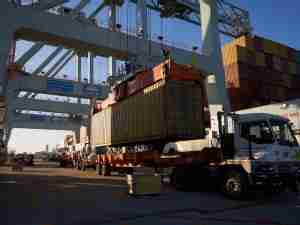CAGTC launched “Freight Can’t Wait” campaign at US Capitol
posted by AJOT | Apr 21 2015 at 01:04 PM | Intermodal
With U.S. freight congestion making news for almost a year, the Coalition for America’s Gateways and Trade Corridors (CAGTC) sent a clear message today: the time to invest in our nation’s freight infrastructure is now. Underscoring that message, the Coalition introduced its new “Freight Can’t Wait” campaign with a booklet of gateway and corridor projects that would offer economic benefits and congestion relief if Congress will act to pass a surface transportation authorization with a fully funded freight grant program. Speaking at Representative Alan Lowenthal’s “Call to Action” event highlighting H.R.1308, the Economy in Motion Act, Coalition members described the prosperity-stifling effect of inadequate infrastructure investment.
“Freight movement occupies a special place in our transportation system as the element that supports and enables national and global commerce,” stated Coalition Executive Director Leslie Blakey. “Freight infrastructure needs dedicated funding. Establishing a competitive grant program with broad, multimodal project eligibility throughout the U.S. is a priority for our Coalition and should be for our country also.”
Thirty-six projects of national significance are featured in the booklet as snapshots from across the country. They include enhancements at freight hubs, sea and land gateways, and the augmentation of roadway capacity to diminish chokepoints in the system.
“Large-scale projects, like the proposed Southern California East West Freight Corridor, are vital to the economic health of the entire nation and require partnership from the federal level,” said Hasan Ikhrata, Executive Director of Southern California Association of Governments (SCAG). “Nationally, an increase in targeted infrastructure investment from public and private sources over 15 years would pay dividends by growing jobs by almost 1.3 million at the onset and it would growing real GDP 1.3 percent by 2020 and 2.9 percent by 2030. These additional jobs would benefit American companies, their workers, as well as promote significant increased international trade.”
Currently, U.S. government infrastructure investment as a percentage of GDP is less than 2 percent, the lowest level of infrastructure investment at any point since World War II. Every $1.00 invested in infrastructure projects raises the level of GDP by about $1.59.
“There is a well-defined federal role in projects that benefit the national economy, like the Port of Long Beach / I-710 Gateway Project. Nearly half of the containers leaving the Port have destinations or origins east of the Rockies. Replacing aging land-side infrastructure and expanding capacity on the I-710 Corridor will mitigate bottlenecks, increase air quality, and improve safety issues,” stated Rick Cameron, Managing Director of Planning and Environmental Affairs, Port of Long Beach.
Last Congress, a bipartisan set of recommendations from the U.S. House of Representatives’ Panel on 21st Century Freight Transportation called for the authorization of dedicated, sustainable funding for multimodal freight projects. Congressman Lowenthal’s comprehensive approach in H.R.1308 has carefully crafted a solution to the House Special Panel’s recommendation, which includes an investment plan as well as a revenue generation strategy, and CAGTC applauds his continued leadership on freight infrastructure investment. His bill has attracted a bipartisan group totaling nine co-sponsors.
“A freight-specific competitive grant program, like the one proposed in Rep. Lowenthal’s legislation, would allow places like the Port of Tacoma to compete for much-needed federal investment,” said Sean Eagan, Governmental Affairs Director for Port of Tacoma. “Funds from a grant program would allow us to partner with the federal government to complete State Route 167. Presently, there are six miles between the highway’s terminus in Puyallup, Washington and the Port of Tacoma. The economic value of completing this last-stretch project would generate 80,000 long-term permanent jobs and $10.1 billion in salaries.”

_-_28de80_-_9b2f972cdce64d5f7c8d952d74a16521db70a589_yes.jpg)






